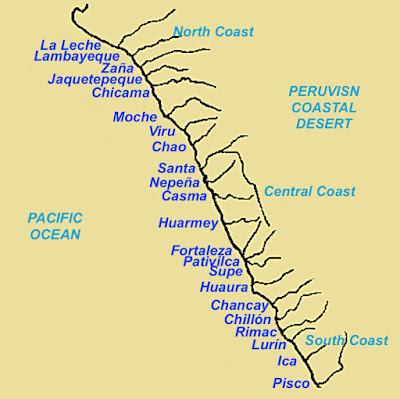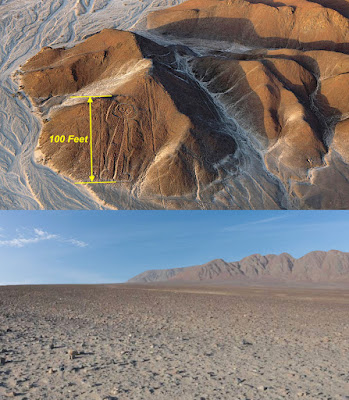As stated previously, this desert in the southwest is littered with round river rock-lined funnels called puquios, that provide a circular walkway down into the aquifer and subterranean river that flows beneath the desert from the mountain area to the sea.
These subterranean aqueducts were built near the present city of Nazca, with a series of acequias or canals that brought to the surface water from the underground water source and channeled it to the areas where it was needed. Any excess was stored in surface kochas or reservoirs, which served as wells and as distribution points for directing the water into the canals. To help keep the water flowing, chimneys were excavated above the canals in the shape of corkscrewing funnels. These funnels admitted wind into the canals, and the difference in atmospheric pressure along the canal length forced the water through the system and eventually to the desired destination (recent satellite imagery also revealed additional previously unknown puquios in the Nasca drainage basin).
Paracas or Nazca aqueducts that dotted the surface were sophisticated
hydraulic systems that allowed the ancient cultures to retrieve water from
underground aquifers, with the water drawn to the surface by the
funnel-shaped holes turned the area into a flourishing landscape able to
support agriculture
According to research scientist Rosa Lasaponara, of the Institute of Methodologies for Environmental Analysis in Italy, who has worked on this puquios system, claims that it was much more developed anciently than it appears today.
The early Paracas, who first settled here were, in turn, followed by the Nazca, who settled in the arid, sub-tropical deserts of the Ica, Nazca and surrounding valleys. They were a people who produced an array of crafts and technologies such as ceramics, textiles, and geoglyphs—specifically the Nazca Lines, with their principle sites being Cahuachi at 1200 feet elevation, and directly across the Pampa de San José on the flanks of the Ingenio River tributary, the sister city of Ventilla, one of the largest urban sites at 200 hectares and hundreds of habitation terraces containing the remains of densely connected houses, some large enclosures an a few artificial mounds with open bounded khanchas in between.
In addition, archaeologist and ethnologist (ethnohistory is a branch of anthropology that analyzes cultures, especially in regard to their historical development and their differences), William Duncan Strong, President of the American Ethnological Society, and Loubat Professor at Columbia, was one of the only archaeologists that took a broad approach to the site, contextualizing it within Nazca society and south coast prehistory. He set out to find stratigraphic evidence that would resolve the gap between Paracas and Nazca styles in the region. He also did settlement pattern studies in order to find out the kinds of activities that went on at Cahuachi—a 370-acre complex of impressive construction about 18 miles from the current town of Nazca. Strong’s findings led him to believe that the Paracas built the early cities attributed to the Nazca, and we may conclude that there was considerable evidence to link these two cultures into one overall people.
In any event, the Nazca were concentrated in the Rio Grande de Nasca drainage, an area classified below 2000 feet as a “pre-montaine desert formation.” Here the area’s rivers originate high in the Andes and the water flows of the coastal valleys is entirely dependent on rainfall in the highlands, which incorporates nine separate tributaries covering an area over 6600 square miles and includes the rivers of Ingenio, Palpa, Aja, Tierras Blancas and Taruga, which extend high into the Andes where they collect the summer rains and water from melting glaciers to provide sustenance in the valleys below.
According to archaeologist Donald A. Proulx, University of Massachusetts in “The Nasca Culture: An Introduction,” the vast majority of domestic sites were small villages or hamlets measuring under 4 ½ acres in size, and located well inland usually flanking the tributary rivers and not along the coast, leaving the coastal desert corridor unoccupied—something that the defector Coriantumr would have well understood, having been born and growing up in Zarahemla, as he led his army through the area toward the city.
The largest of the Nazca settlements was the massive pyramid complex known as Cahuachi, which was located 250 miles south of Lima and several miles inland from the coast.
Top: The Cahuachi truncated pyramid
complex of Cahuachi about six miles south of Nazca. There are 36 to 40 separate
pyramids in this isolated area, and it is claimed they were abandoned at the
close of the fourth century AD
In addition, the Nazca culture built more than 40 subterranean aqueducts more than 1500 years ago in teh 5th Century AD or earlier (Katharina Schreiber and Josue Lancho Rojas, Irrigation and Society in the Peruvian Desert, Lexington Books, Lanham, Maryland, 1999, p6), and have never been fully mapped and none have been excavated (M. Barnes, “Dating of Nazca Aqueducts,” Nature, Vol.359, No.111, 10 September 1992). These aqueducts, or puquois, ensured the supply of water to the city of Nazca and the surrounding fields, allowing the cultivation of crops in an arid region. Nearly all are still operating and even relied upon to bring fresh water into the arid desert (Judith Proulx and Donald A. Rickenback, Nasca Puquios and Aqueducts, University of Massachusetts, originally published as Nasca: Geheimnisvolle Zeichen im Alten Peru, ed Judith Rickenbach, Museum Rietberg Zürich, Zürich, 1999, pp89-96).
When the defector Coriantumr with his Lamanite army reached the coastal
area past the Nazca settlements, he turned north toward Zarahemla
The foothills along the eastern edge of the desert coastal strip in the
area of Nazca north to Ica. It is a desolate area with few settlements and open
desert land
Thus, when he reached the city, he was able to easily fight his way into it and conquer the capital because of his surprise approach from the south and not form the east, which had always been the Lamanite route into the Land of Zarahemla in the past. From there, as we stated earlier, Coriantumr went northward, toward the “north countries,” taking the central route or road through the highlands toward Bountiful. Wanting to cut his way through the unprotected Nephite lands, destroying his enemy as he went, Coriantumr chose to travel up “he center of the land, therefore he did march forth, giving them no time to assemble themselves together save it were in small bodies; and in this manner they did fall upon them and cut them down to the earth” (Helaman 1:24).
However, his march “through the most capital parts of the land, slaying the people with a great slaughter, both men, women, and children, taking possession of many cities and of many strongholds” (Helaman 1:27) slowed his progress, and allowed Moronihah to send “Lehi with an army round about to head them before they should come to the land of Bountiful” (Helaman 1:28), and Moronihah brought his army up behind Coriantumr’s forces (Helaman 1;30), and the Nephites caught the Lamanties between their two strong forces, killing Coriantumr, and eventually recapturing the city of Zarahemla (Helaman 1:33).


































